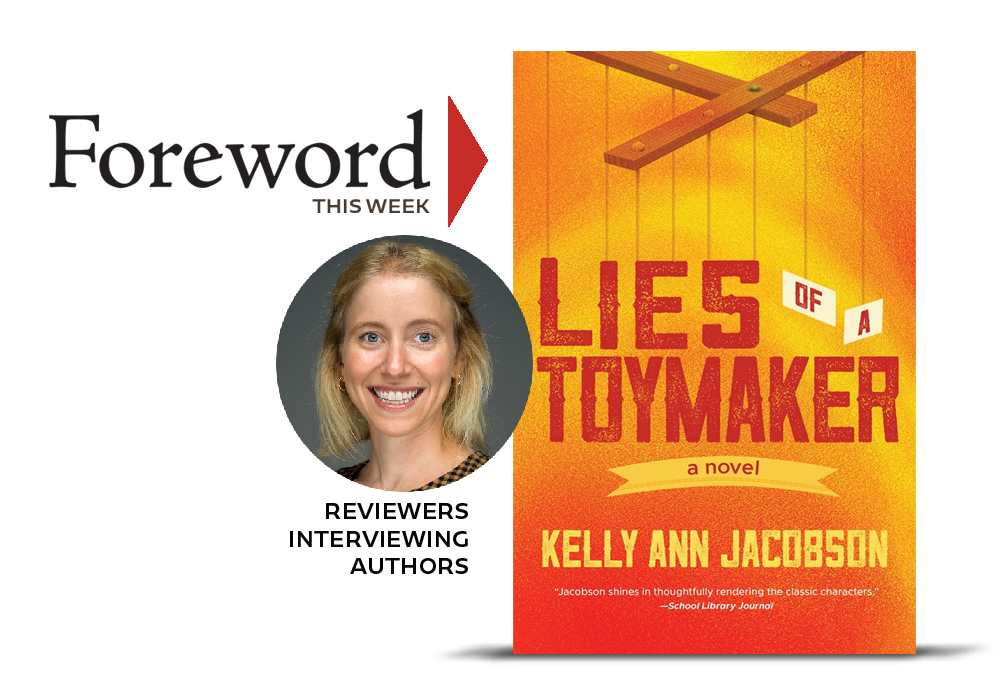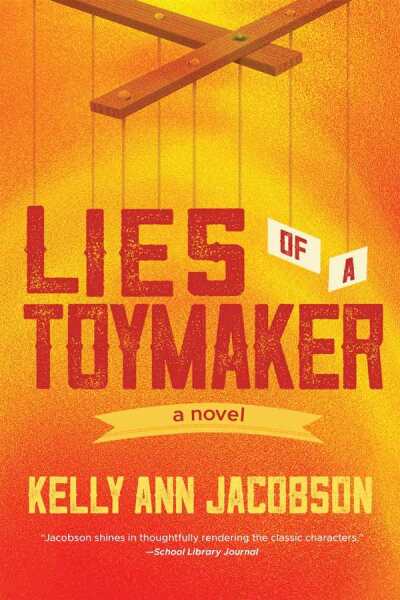Reviewer Brandon Pawlicki Interviews Kelly Ann Jacobson, Author of Lies of a Toymaker

“In our society we seem to think that queer people have some need to ’come out,’ and that until they have, they are ’lying’ to others about their true identity. In this book, the idea of people earning your trust and your truth is more important.’’ —Kelly Ann Jacobson
Kelly Ann Jacobson’s quote above is brilliant in forcing us to confront our assumptions about the queer experience. Why would we assume that everyone under the LGBTQ+ umbrella hid their sexuality until one magical day when they mustered the nerve to come out?
But Kelly Ann also identifies a supremely important element of the human experience: that trust and truth in close relationships allow us to be the people we want to be—and that is where she puts her creative focus in Lies of a Toymaker, a fiercely feminist, queer retelling of Pinocchio.

The author of Tink and Wendy, Robin and Her Misfits, and many other YA and adult books, Kelly Ann is a virtuoso of reimaginings, but what she finds most interesting about the classics of children’s literature and their famous characters is the deeper themes underlying the stories. That’s where her imagination takes over—to the point where she often can’t keep track of her ideas.
In her interview with Brandon Pawlicki, Kelly Ann also mentions that she’s currently working on a textbook for Bloomsbury Academic. The working title: Young Adult Fiction Writing. We can’t think of anyone more qualified.
Young Adult fans, check out the five other great books in the YA feature in Foreword’s March/April issue, including Beasts, a Levine Querido project which earned a starred review from Rebecca Foster.
Use this direct link to your free digital subscription to Foreword Reviews.
What was the initial inspiration for you to tackle your own telling of Pinocchio?
Last fall, I was asked to give a talk at Shenandoah University on queer retellings, and I happened to spend the following morning in Winchester walking around the downtown area. Retellings were on my mind, and as I walked past a toy store, I somehow put the idea of retellings and a toy store together. This led me to Pinocchio, and as I turned a corner and began to walk down another road, I pictured a girl at the wheel of a toymaker’s caravan, not yet knowing that she was going to start turning to wood. Winchester became Wintroster in my book, and the toy shop became Toy Palace, which turns out to be owned by Paige’s evil relative. She even eats the same bagel I ate during my visit. This was one of the clearest “Aha!” moments in my writing career!
Were there any elements from the original tale, or other iterations of it, that you knew you wanted to keep or expand on?
I knew that I wanted to keep the idea of Pinocchio’s nose growing somehow, so in my book, Paige turns into wood a little more every time. I also knew I definitely wanted to keep the Blue Fairy, since anyone who knows me knows I love a good fairy or dragon (and there may or may not be both somewhere in this book …). A lot of other familiar characters ended up making appearances without me necessarily knowing ahead of time that they were going to, such as the shark that swallows some of the characters, Medoro the dog, and, of course, Cricket!
Were there any elements from past tellings that you wanted to leave behind?
I wanted to keep the idea of “lying,” but I knew I wanted to twist that idea around to show more nuance than just “truth” and “lies,” especially in terms of the queer experience and the idea of “coming out” versus “letting in.” In our society we seem to think that queer people have some need to “come out,” and that until they have, they are “lying” to others about their true identity. In this book, the idea of people earning your trust and your truth is more important.
Paige also “lies” to her mother, but the reason is not that Paige is trying to deceive Petta—rather, it is Petta’s deception and the fact that her needs and secrecy are always overwhelming Paige’s own needs that causes Paige to lie to her.
Typically, in my reimaginings, these are the kinds of twists I try to include—they are taking a lot of inspiration from the original characters, but the deeper themes always get analyzed, to the point where we start wondering if believing them is problematic in the first place. For example, is believing so much in “truthfulness” as “goodness” a problem? How so?
Were there any challenges for you during the writing process? Any roadblocks along the way?
Oh, yes. I am a very imaginative writer, but sometimes that means I have trouble keeping track of my ideas. That’s why good editors are so important! I was very lucky that Arden Paterson at Three Rooms Press understood my vision, and could really help me solidify the lore of the world and keep my Fae powers consistent.
For a while during the initial writing of the book, I struggled with finding the structure of the book and the main points of view. I knew I had to have Paige, so I wrote a lot of her chapters first thinking the first section would be entirely from her point of view, and then Alexio emerged, and I started wondering if maybe the book would have a lot of different points of view. Later, I had to go back and write entire points of view, such as Petta and Lily, and then figure out how to weave them all together from the beginning of the book to set the expectation for the reader that they were going to be moving around a lot and also making sure all of the arcs for the characters were in sync. I should have seen it coming—my novel Tink and Wendy alternates between “then” and “now” and “Neverland: A History” chapters, and my novel Robin and Her Misfits has all five of the Misfits as point of view characters.
Did you have any characters, scenes or ideas that didn’t make it into the final book?
Rather than things not making it into the book, I actually ended up adding a lot of things. For example, Lily’s chapters (she is the Toy Palace Manager) got added at the very end of the drafting process, but before I sent the book to my publisher. I always had sections written from her perspective, but they were epistolary “manager’s logs,” and by the end of the writing process I felt like her story just wasn’t coming across as much as I wanted it to, especially because of how big of a role she ends up playing in so many of the character’s lives and how central her story is to the overall theme. I expanded those into fully fleshed-out chapters, and I added a lot more of them throughout.
I also added a reactive scene after Paige first comes to the Land of Toys, which was not in my initial version. That part was very action-packed—come over to the Land of Toys, immediately face demonic Patched toy creations—and my editor encouraged me to add more there so that Paige could take a breath and process what had just happened.
Are there any plans for a sequel?
I actually just finished writing it three weeks ago! That was another gift from my editor—I had not thought of writing a sequel before, and I am fine with more than the average amount of open-endedness at the end of a book, but once Arden suggested the idea, I thought, Well, of course there needs to be a sequel!
This one has a lot of new point of view characters, but you still get to see what happened to everyone you loved from the first book, and the Fae universe gets much bigger as we see many new types of Fae emerging from the woodwork to battle Candlewick, who you’ll recognize because of the name from Pinocchio’s troublemaking friend from the original story. My Candlewick also has donkey ears!
What’s next for you? Do you have any other projects in the works that you’re especially excited about?
I am currently working on a really big project—a textbook called Young Adult Fiction Writing that I’m doing for Bloomsbury Academic! The book involves a craft half and an anthology half, so right now I’m reading a lot of young adult novels and determining what selections will go there. The book is really fun because it will have interviews with published authors and a lot of vision questions to help writers figure out what works for their book rather than promoting the idea that there is one “right” way to write a young adult novel. I took a break to write my sequel, but now it’s time to circle back and dive into the textbook again for a while—at least until the next reimagining inspiration strikes when I’m least expecting it to!
Brandon Pawlicki
